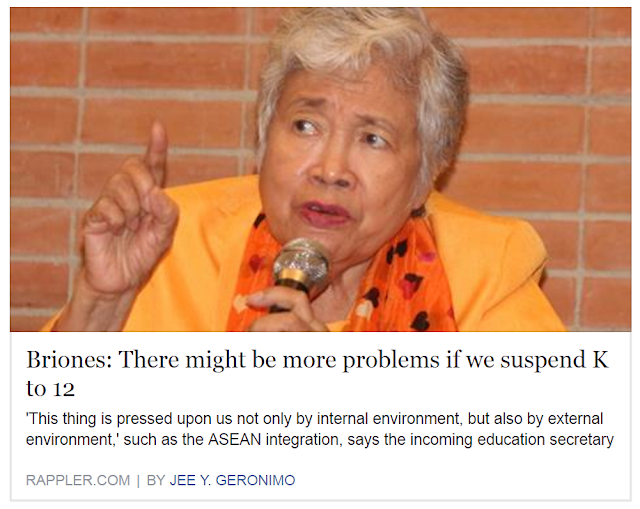A year ago, Philippine Education secretary Leonor Briones lamented that K to 12 must continue. Otherwise, there might be more problems. One excuse she gave was "with or without K to 12, you will have 50% of those who graduate from elementary who cannot proceed – that is the record." In addition, four years had already been spent preparing for the new curriculum. Fast forward to this week's opening of classes, enrollment and dropout figures are unclear. Anakbayan's Einstein Recedes claims that there are now 2.5 million additional dropouts based on 3.9 million students in grade 10 for the school year 2015-2016 and only 1.4 million students enrolled in grade 11 for 2016-2017. This calculation appears to be incorrect since there are only 1.3 million students enrolled in grade 10 in public schools in 2015-2016. The 3.9 million figure is apparently an upper estimate of how many students will be enrolling in both grades 10 and 11 for this current school year. Nonetheless, the numbers provided by the government with regard to how many actually enrolled in grade 11 this past school year are likewise mysterious. At the beginning of the school year 2015-2016, at least one region,
Central Luzon, was reporting that 42 percent did not enroll. Magically, right before Briones reported to the Senate,
senior high school enrollment for 2016 reached 1.5 million.
The reason why government figures seem inaccurate can be easily seen by simply following the money. Since there are not enough public schools in the Philippines to offer the additional years of high school, a voucher program has been established.
It is in this DepEd's voucher program that Recedes obtained the projected numbers for senior high school enrollment.
The figure 3.9 million therefore corresponds to what DepEd projects for both 2016 and 2017. The funds allotted for the voucher program for 2016 is 12 billion pesos. Assuming Tier 1 (22,500 pesos per student) at 100%, this funding can support about 0.5 million students, which is far less than half the projected number shown above (Half of 0.8 M - 1.0 M from public JHS to Non-DepEd SHS plus 0.7 M from private JHS to private SHS is 0.75 M - 0.875 M). What is more perplexing is how much of this fund has been spent for 2016.
607,208 beneficiaries for an actual payment of 3.95 billion pesos amount to 6500 pesos per student, which is even less than the lowest possible voucher amount of 8750 pesos (Tier 3, 50% for SUC's and LUC's). The numbers do not really make any sense at this point. 3.95 billion pesos at the full voucher amount of 22500 pesos per students can support only 0.18 M students. After all, there is a reason why 12 billion was initially allocated. 12 billion pesos can support 0.75 M students at the rate of 16000 pesos per student, the median value of a voucher. What is therefore crystal clear is that the majority of the funds for the voucher program have not been spent thereby casting an overwhelming shadow of doubt on the government's enrollment numbers.
Recedes' numbers for school dropouts may have been incorrectly overstated (so did Al Gore's prediction for global warming, but that does not mean that climate change is a hoax). Nevertheless, the government's figures claiming that the additional years of high school did not force students to leave school remain highly questionable. The Philippine government cannot hide the fact that problems will only get worse with K to 12. The reason is simple. The numbers are shouting at us. As
Congressman Tinio explains, "We attribute low enrollment and high drop-out to the alarming shortage of public schools, especially high schools, and the insufficient budget for their maintenance and operations." K to 12 significantly increases the resources required for Philippine basic education therefore exacerbating the problems caused by insufficient funding especially for high schools. There are only 7,000 public high schools compared to 36,000 public elementary schools in the country. K to 12 adds enormous burden to a public high school system that is already sufferring severe shortages. The arithmetic is really quite simple.
During last year's school opening, DepEd secretary Briones asked this question:
"Right now, from where I am, from my own involvement in the 4-year process of preparation, the question that we have to raise is, which is more harmful: to stop it at this time, to suspend it at this time, or to continue and to recognize the deficiencies?"
A main fault in DepEd's K to 12 is its failure to address the major problems in Philippine basic education. It adds years to high school where resources are already problematic. It does not address the fact that a large number of elementary school graduates are not really prepared for high school. DepEd's K to 12 basically demoted its old high school of four years to a "middle school" and created a new high school that is only two years long. If the objective is to lengthen basic education by two years, a much more reasonable place to add these years is at the end of elementary school. And there is still time to change since this school year marks the implementation of the new sixth grade curriculum. Seventh and eight grade curricula have already been implemented. What simply remains to be done is to look again at the four years of high school and adopt a curriculum that is basically similar to that of the United States. Middle school makes a lot more sense than senior high school.




Comments
Post a Comment